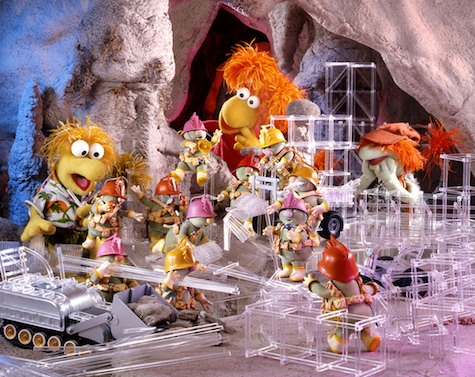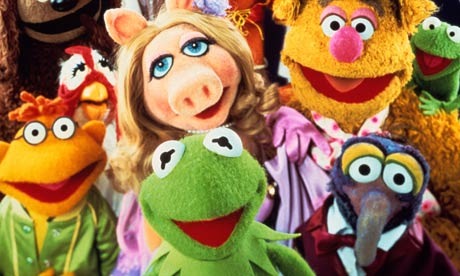The fast food chain Chik-Fil-A’s recent confirmation of a vehement stance against marriage equality prompted a fascinating response from The Henson Company earlier this week. In reply to the chain, the company’s CEO—Jim Henson’s daughter Lisa—declared the company’s support of equal marriage rights, making it known that every cent gained from the partnership between the food chain (Muppet toys were available in Chik-Fil-A meals) and the Henson Company would be donated to GLAAD (Gay & Lesbian Alliance Against Defamation).
Many are insisting that this could only be expected from the company that brought you a pair of roommates with almost-matching wardrobes. But while ruminating on Bert and Ernie’s potential love life may have the general public snickering—although that joke has been going for so long that it might actually no longer be funny—what doesn’t seem to enter the conversation are the places where Henson worlds and creations make a point of opening the doors to understanding.
Sesame Street has always been a place where everyone was meant to feel at home, and that has always been reflected in its programming. Like The Muppet Show, Sesame Street is known for showcasing a wide variety of celebrity hosts, no matter their color, creed, or sexual orientation. In addition, it has been noted that Sesame Street segments discussing subjects such as love and marriage have never been too keen on organizing definitions according to heteronormative standards; when Grover asked children about what marriage was, the answer he received was “when two people get married.”
What people infer can amount to much more than what you intend, and all of these little bits and pieces add up to what many are viewing as the new “gay-friendly” Sesame Street. But calling it an agenda seems an overreaction when Jim Henson’s work has featured diversity of all kinds from the very beginning. Guest hosts, a pantheon of funny-looking puppets, and songs about rainbow connections have mixed and mingled to thrilling combinations of talent in every aspect of production. The only prerequisite that seems to exist for working on Sesame Street or any other Henson project is a desire to be creative, silly, profound, and accessible to everyone.

That hardly amounts to widespread support for gay rights, but while the producers of the show have been quick to deny any deliberate leanings, Henson endeavors have been a pillar of inclusive entertainment for years. Perhaps an even better example of this would be the show Fraggle Rock. Set in a fantastic world with links to our own, the Fraggles lived with Doozers, and right outside their homes was a garden kept by Gorgs. The show made a point of showing how Fraggle society worked, and how different types of people formed symbiotic relationships; it is discovered further into the show that while the Fraggles are constantly destroying the structures created by Doozers (by eating their Doozer Sticks), they are in fact contributing to the natural order—if they don’t eat the structures the Doozers have no room to build and have no purpose.
It sounds like a great lesson for environmental awareness, but it also teaches children that not being able to understand what someone does is no reason to withhold you appreciation or respect from them. The young Doozer Cotterpin, who is at first dissatisfied with her life of building and is given a special role among Doozers, eventually befriends some of the Fraggles and they learn through her in turn. At the show’s end, the Gorg’s son Junior is given the opportunity to see life from a Fraggle’s perspective. He ends up appreciating them so much that he reforms the structure of their society and gives everyone an equal say. His choice to stop viewing the Fraggles as pests changes the shape of their whole culture.
The Dark Crystal might be the most carefully constructed example of the Henson Company’s belief in equality amongst all people. After watching the Skeksis torment and sow destruction through the entire film, after making them appear undeniably evil, they eventually meld with the gentle, wise Mystics and become whole. The final thoughts imparted to the young hero Jem are a lesson for any age: we are all a part of each other. Even something that might terrify you at the start is still a piece of your world, and should be embraced. What makes us different is also what binds us all together, and that should never be ignored in favor of fear.
Then there are the Muppets, a gang of the most unlikely friends you could ever meet. If there was ever a bid for acceptance in Jim Henson’s colorful array of creations, the Muppets would be the first to shout it loud. Here is a troupe that counts a frog, a pig, a bear, and a whatever among their ranks—could you imagine them frowning on any modicum of uniqueness they ever came across? When they’ve got a cadre of singing chickens at their disposal?
It isn’t necessary to parade gay characters in front of children in order for them to get these messages, and the lessons inherent in Henson’s work are a testament to that inclusive outlook regardless. But that doesn’t mean that we don’t want our heroes to put their money where their mouth is; it’s one thing to promote diversity in your entertainment, but it’s quite another to publicly announce what your business stands for. Those are the moves that can cost a company money and make a lot of people angry.
So while we will all hold those muppet-y teachings close to our hearts, it is perhaps even more heartwarming to know that the Jim Henson Company really does count equality among their top priorities. It proves that while Bert and Ernie may never have a sexuality to speak of, all sorts of families will always be welcome on Sesame Street.
Emmet Asher-Perrin is pretty sure that we should leave Bert and Ernie alone and all start pointing the finger at the real secret relationship between Bunsen Honeydew and Beaker. You can bug her on Twitter and read more of her work here and elsewhere.










